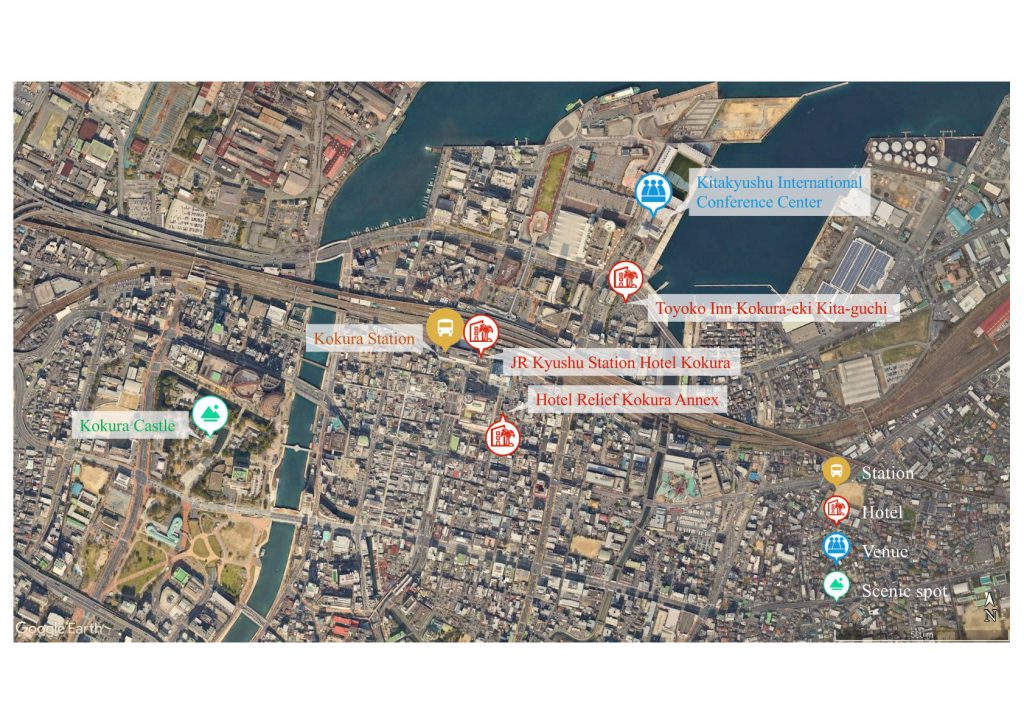Accommodation
We recommend different types of hotels for all attendees. Please make your own reservations directly with the hotel. Here are the details for reservations:
Toyoko Inn Kokura-eki Kita-guchi (About 5 minutes on foot)
- 2-16-21 Asano, Kokurakita Ward, Kitakyushu, Fukuoka 802-0001. Reservation call: 093-513-1075
- Guests are entitled to check-in from 4pm to 10pm on the day of arrival until check-out at 10am the following day.
JR Kyushu Station Hotel Kokura(About 14 minutes on foot)
- 1 Chome-1-1 Asano, Kokurakita Ward, Kitakyushu, Fukuoka 802-0001. Reservation call: 093-541-7111
- Guests are entitled to check-in at 3pm on the day of arrival until check-out at 11am the following day.
- Room information and booking links: https://www.station-hotel.com/
HOTEL RELIEF Kokura Station(About 13 minutes on foot)
- 3 Chome-6-1 Kyomachi, Kokurakita Ward, Kitakyushu, Fukuoka 802-0002. Reservation call: 093-513-0088
- Guests are entitled to check-in at 3pm on the day of arrival until check-out at 10am the following day.
- Room information and booking links:https://www.hotel-relief.jp/kokura/

Tourist Spot
Kitakyushu City is located at the northernmost tip of Kyushu, facing Honshu across the Kanmon Strait. In 1963 (Showa 38), five cities at the time merged to become Kyushu’s first designated city under the Local Autonomy Law. Currently, the city consists of seven administrative wards: Moji Ward, Kokura Kita Ward, Kokura Minami Ward, Wakamatsu Ward, Yahata Higashi Ward, Yahata Nishi Ward, and Tobata Ward.
As the central hub, Kokura Station serves as the gateway to Kyushu, with all Shinkansen trains stopping there, offering excellent convenience. Surrounding the station are numerous large-scale commercial facilities, attracting shoppers and other visitors.
Kitakyushu City boasts world-class environmental and industrial technology accumulation, with urban infrastructure including airports, ports, and more. At the same time, the city is blessed with natural landscapes such as the scenic Mt. Sarakurayama and one of Japan’s three major karst plateaus, Hirao Plateau, allowing people to experience the beauty of nature up close.
- Mojiko Retro district
- The Port of Moji (Mojiko) is an international trade port opened in 1889 and located at the northern edge of Kyushu. Its prosperity as a transport hub attracted many Western-style buildings housing shipping companies and trading firms around it. The Mojiko Retro district is a restored reproduction of the district around the port in olden times. In this district, various buildings have been preserved and are open to visitors, including the iconic Mojiko Station, former Moji Mitsui Club, where Einstein stayed, and former Kyushu Railway Headquarters (currently Kyushu Railway History Museum). You can immerse yourself in the atmosphere of Japan in the late 19th to early 20th centuries here.
- Wakato Bridge
- Wakato Bridge was a forerunner to Japan’s other long suspension bridges, coming before the Seto, Rainbow, Akashi Kaikyo, and Kanmon bridges. The large-scale bridge is 627 meters long and is admired as a symbol of the two wards it connects, Wakamatsu and Tobata. Its bright crimson color makes such a strong impression that, when it was built in 1962, it was called the dream suspension bridge, the longest in the Orient. At the foot of the bridge on the Wakamatsu side, you can find plenty of retro buildings, such as the Former Furukawa Mining Wakamatsu Building and the Ueno Building.
- Kokura Castle
- The castle was built in 1602 by Hosokawa Tadaoki. The castle tower burnt down in 1837, but was reconstructed in 1959 thanks to the hope of the citizens. Exhibitory inside the castle tower was renovated and the reopened in March 2019. Also, there is a stunning Japanese Garden next to the castle. Here, you can get exposed to Japanese culture such as Japanese manners and a Japanese tea ceremony.
- Mt. Sarakura
- Mount Sarakura is said to be the foremost of Kitakyushu nightscapes. Transfer from the cable car to the slope car (a kind of monorail) to arrive at the mountain’s summit of 622 meters, where an observation deck affords you an unbroken view of the city. The scenery spread out beneath your eyes is called “the 10-billion-dollar nightscape,” and is recognized as one of the New Three Major Night Views of Japan. The observation deck’s restaurant allows you to enjoy a panorama with a field of view of over 200 degrees while dining. The Tenku Dome (Sky Dome) on the summit is illuminated with holiday lighting on the weekend, making it a popular destination for couples on a romantic date. Some paths also available for mountain climbing, for which the area is also loved by city residents.
- Hiraodai Limestone Plateau
- Hiraodai Limestone Plateau is counted among the 3 major karst formations in Japan and has been designated a natural monument, a quasi-national park, and prefectural natural park. There is scenery to be enjoyed in each of the 4 seasons, including the burning off of fields in spring, the new greenery of summer, and Japanese pampas grass in fall. The many ways to have fun include learning about the nature found at Hiraodai Limestone Plateau at the Hiraodai Nature Observation Center, viewing caves at Senbutsu Limestone Cavern, Mejiro Limestone Cavern, and Ojika Limestone Cavern, and exploring nature through caving.
